‘Maman’ up close
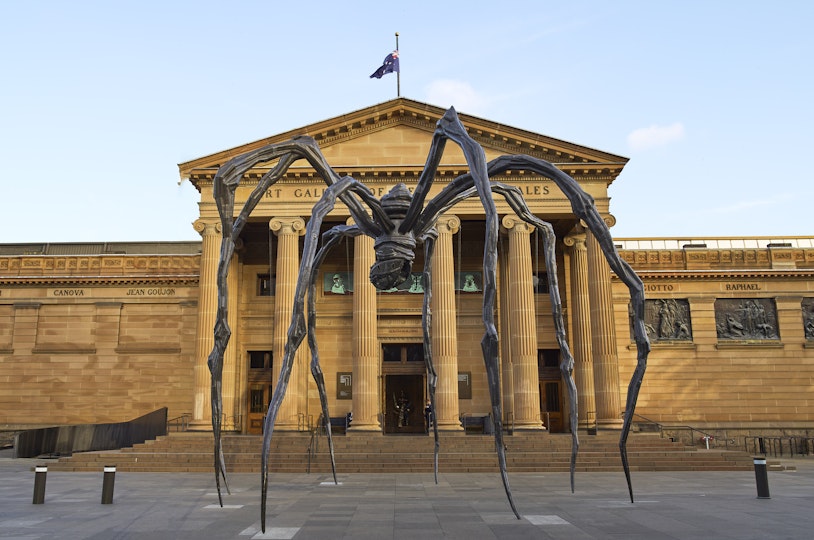
Louise Bourgeois’s Maman 1999, installed during the exhibition Louise Bourgeois: Has the Day Invaded the Night or Has the Night Invaded the Day? at the Art Gallery of New South Wales © The Easton Foundation/VAGA at ARS/Copyright Agency 2023, photo © The Easton Foundation/Art Gallery of New South Wales, Felicity Jenkins
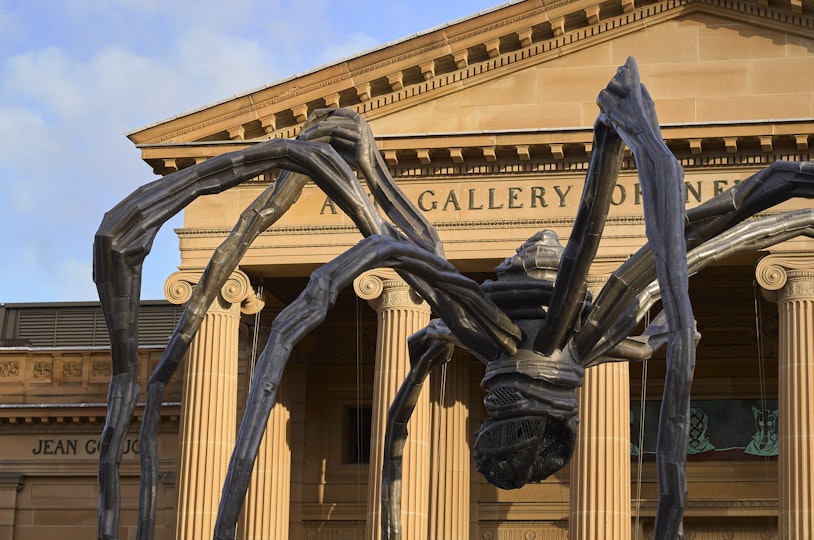
Louise Bourgeois’s Maman 1999, installed during the exhibition Louise Bourgeois: Has the Day Invaded the Night or Has the Night Invaded the Day? at the Art Gallery of New South Wales © The Easton Foundation/VAGA at ARS/Copyright Agency 2023, photo © The Easton Foundation/Art Gallery of New South Wales, Felicity Jenkins
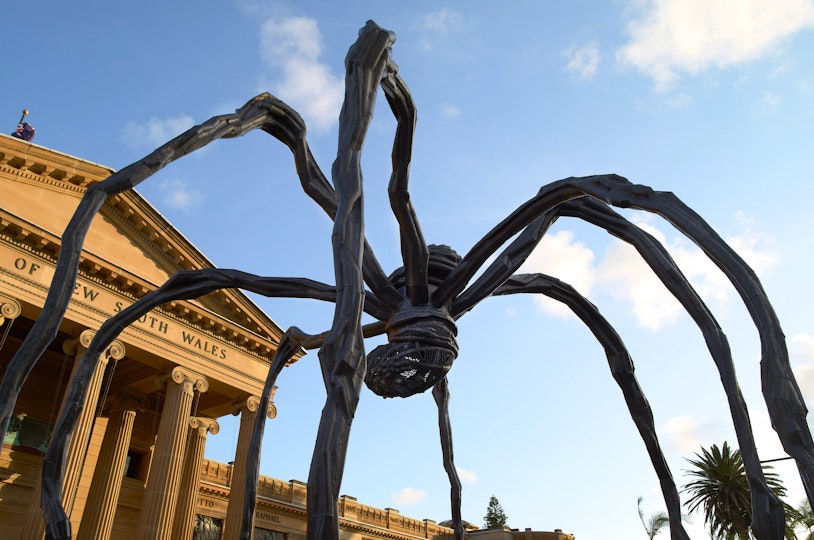
Louise Bourgeois’s Maman 1999, installed during the exhibition Louise Bourgeois: Has the Day Invaded the Night or Has the Night Invaded the Day? at the Art Gallery of New South Wales © The Easton Foundation/VAGA at ARS/Copyright Agency 2023, photo © The Easton Foundation/Art Gallery of New South Wales, Felicity Jenkins
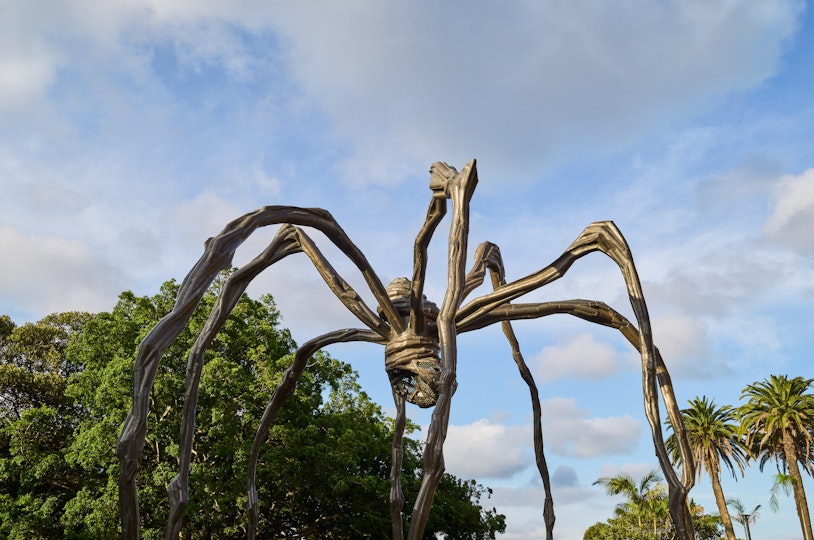
Louise Bourgeois’s Maman 1999, installed during the exhibition Louise Bourgeois: Has the Day Invaded the Night or Has the Night Invaded the Day? at the Art Gallery of New South Wales © The Easton Foundation/VAGA at ARS/Copyright Agency 2023, photo © The Easton Foundation/Art Gallery of New South Wales, Felicity Jenkins
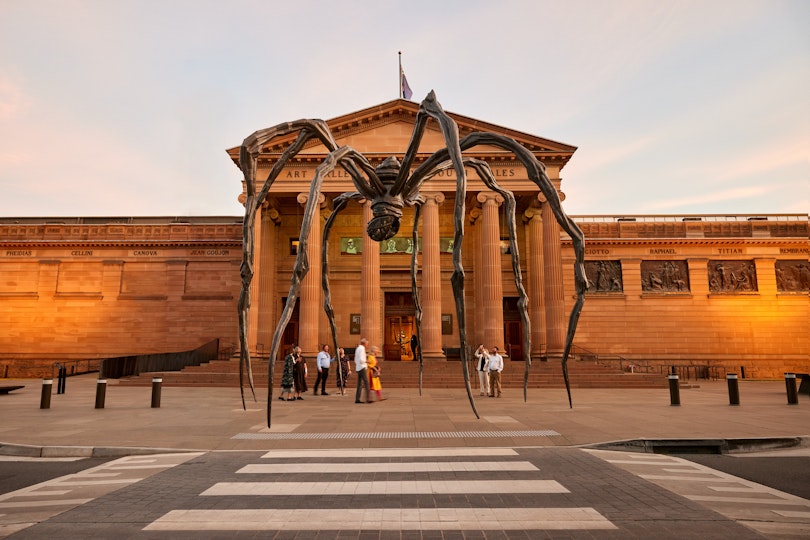
Louise Bourgeois’s Maman 1999, installed during the exhibition Louise Bourgeois: Has the Day Invaded the Night or Has the Night Invaded the Day? at the Art Gallery of New South Wales © The Easton Foundation/VAGA at ARS/Copyright Agency 2023, photo © The Easton Foundation/Art Gallery of New South Wales, Felicity Jenkins
The history of monumental sculpture is crowded with heroic male figures. Maman 1999 is something rarer – a monumental mother, and a homage to the mother, by the great French–American artist Louise Bourgeois.
‘Maman’ is a term of childlike familiarity, similar to ‘mum’ or ‘mummy’ rather than ‘mother’. This intimacy only heightens our sense of the fantastical size and power of this spider. She seems battle-ready with her armoured limbs and belly loaded with marble eggs. Who wouldn’t want Maman as their protector? Who wouldn’t fear to provoke her?
In Bourgeois’s art, spiders relate to the artist‘s mother Joséphine, a tapestry restorer. Like Joséphine, the spider is precise and constructive, with a talent for weaving. Like an artist, the spider works with her body to create shelter and structure. ‘If you bash into the web of a spider,’ Bourgeois said, ‘she doesn't get mad. She weaves and repairs it.’
-
‘Maman’ facts and figures
This sculpture is one of six bronze casts. The first sculpture, from which these casts were made, is made of steel and is in the collection of the Tate Modern, London. The marble eggs in all sculptures are made of white marble from Carrara, Italy.
Maman comprises of 16 bronze leg sections, two bronze body sections, 20 marble eggs and eight steel footing plates.
It measures 9.271 x 8.915 x 10.236 metres.
The total weight of the sculpture is approximately 10,909 kilograms, with each of the eight legs weighing 1250 kilograms. The weight is distributed evenly between the legs.
It’s here. Or should we say she is here. Maman, by Louise Bourgeois. One of the past century’s greatest sculptures by one of its greatest artists.
Take a moment to size up/take the measure of Maman. Walk around her. Feel her height, her grandeur. And think, as you stand underneath her, of the history of monumental sculpture. Of the tonnes of bronze poured across the centuries to make sculptures of heroic figures. Soldiers, generals, presidents, victors, athletes, horsemen. But not many women, and not many mothers. Which is why Bourgeois’s Maman is not just arresting but pivotal.
For here is a sculpture, nine metres high, a creature so large it is architecture, which is also a homage to Bourgeois’s mother, and to the Mother more broadly. ‘Maman’ means mother but more precisely ‘mummy’. It’s a child’s word, intimate and affectionate. And this childlike intimacy only heightens our sense of the fantastical size and potency of this spider. It seems battle-ready with its limbs of bronze and its cage-like abdomen loaded with eggs. Who wouldn’t want Maman as their protector? Who wouldn’t fear to provoke or disobey her?
For we all become children again, don’t we, when we feel our smallness below this form. And we remember, too, the enormity of the feelings we projected on those who raised and controlled us: love, reverence, devotion, respect, but also fear, fury, frustration, and wild need. In this sense Maman, for all her height and weight, is a psychological entity. Looming over us physically, she also takes up residence in our memories and our minds. And like the monstrous creatures in fairy tales and myths, she instils an awestruck humility. It’s useful to be reminded that, from a certain perspective, we humans look small as insects.
Spiders always relate in Bourgeois’s art to her mother Josephine, a tapestry restorer. Like Josephine, spiders are patient and constructive, with a talent for weaving and repairing. As she works precisely to build her web, the spider is also an artist. Drawing materials out of her own body, she creates geometry, shelter and order. And she stakes a claim here, in front of the male artists’ names on our building, for female and maternal creative powers.
Maman is just the first of almost 130 works in our Louise Bourgeois exhibition. Head to the new North Building and our ticket office to enter the web of her art.
-
01
Listen to curator Justin Paton speak about ‘Maman’
We’re on the forecourt of the Art Gallery of New South Wales’ original building, also known as the South Building. Several metres in front of the steps leading up to the sandstone entrance is an enormous bronze sculpture of a spider. The sculpture is Maman by the French–American artist Louise Bourgeois. Bourgeois created Maman – a French term similar to ‘mum’ or ’mummy’ – in 1999 when she was in her late eighties.
You’re likely to hear murmurs of delight and wonder from other visitors as they encounter Maman. As you move around and underneath the sculpture, you might feel the changes in light and shadow cast by her vast proportions.
The sculpture‘s materials are bronze, silver nitrate patina, stainless steel and marble. Maman weighs 11 tonnes. At 9 metres high, she is as tall as some of the Moreton Bay fig trees across the road from the South Building. The diameter covered by her eight legs is 10 metres.
Maman’s legs emerge from the centre of her body in jagged, slightly upward right angles. The legs are spaced about 3 to 4 metres apart from each other. The upper part of each leg joins the lower part in a sort of knuckle. The legs consist of several sinews that twist around each other. As the legs descend, they become increasingly thin and end in dainty points approximately 5 centimetres in diameter.
The spider’s central body is about 2 metres tall and 75 centimetres wide. It’s shaped like two fists stacked on each other. A thick spiral or coil of bronze twists around the top half of the body. The bottom half of the body, also in bronze, is a mesh-like basket or cage. This is the egg sac that holds Maman’s 20 smooth marble eggs. Ovular in shape and pinkish white in colour, each egg is about the size of an adult head and weighs 9 kilograms.
The sculpture is one of more than 120 works in the exhibition Louise Bourgeois: Has the Day Invaded the Night or Has the Night Invaded the Day? at the Art Gallery’s new North Building. You can also listen to curator Justin Paton speak more about this sculpture as part of the exhibition audio guide.
-
01
Listen to an audio description of ‘Maman’
-
K–6 discussion questions
Humans are bigger than spiders. Maman, on the other hand, towers above us. Measuring over 9 metres tall, this giant spider is one of Bourgeois’s most ambitious projects. What effect do you think the scale of this spider might have on someone standing beneath it? Is it terrifying or awe-inspiring? How do you think the artist created such a big sculpture? What is it made of, and how did it get to be outside the Art Gallery of New South Wales?
Bourgeois’s mother Joséphine was a tapestry restorer and an important role model. ‘The spider,’ wrote Bourgeois, ‘is an ode to my mother. She was my best friend.’ The title of the work, Maman, is a French word for ‘mum’ or ‘mummy’. In what ways do you think this sculpture represents the artist’s mother, or a ‘mum’ in general? Make a list of traits or characteristics that describe both spiders and a mother, parent or carer. Discuss your ideas with the class.
Maman travels around the world. You can find other Maman sculptures like this one in the UK, Spain, Canada, Japan, America and Qatar. If you look closely, you can see that Maman has a sac carrying 20 marble eggs. Do you think she will lay her eggs at the Art Gallery of New South Wales? Imagine all the places this spider has been, maybe searching to find a place to lay her eggs. Write and illustrate a story about the life of Maman based on her travels and what she has seen. Where will she call home?
-
K–6 activities
Use your spider senses to detect what Maman is doing or planning to do. Is she resting or is she about to crawl away? Which way will she go? How will she move – fast or slow, or will she jump or scuttle? Create a flip book or stop-motion film to express your imaginative thoughts and ideas.
Bourgeois wrote every day, filling diaries with poems, thoughts and ideas. As a class, sit in a circle and weave a tale. Build a collaborative story about a spider larger than life. One person will begin the story with a word and then pass to the student beside them, who will add another word, and so on. Write your story down and illustrate it.
Think about the experience of looking up at Maman from below, like a child looking up at parent or grown-up, or a spider looking up at a person. How does this flip in scale make you feel? Choose an insect or a small animal and create a sculpture of it in a larger-than-life scale. Consider a place on your school grounds to display your sculpture. How do students and teachers react when they see it?
-
7–12 discussion questions
Maman and many of Bourgeois’s spider sculptures may be read as referring to maternal figures: the artist’s mother, an archetypal mother, a symbol of motherhood, or the artist herself. In a March 1975 diary entry, Bourgeois wrote, ‘You need a mother. I understand but I refuse to be your mother because I need a mother myself.’ Discuss this quote and the role of motherhood in Bourgeois’s art. How does Maman enact these different types of maternal figures? Who are some other artists that draw on the theme of motherhood in their practice, and how does their approach compare to Bourgeois’s?
Look closely at Maman’s spiralled body and egg sac. For Bourgeois, the spiral is ‘an attempt at controlling the chaos’. She often included these coiled forms in her work; she wrote: ‘Spirals – which way to turn – represent the fragility in an open space. Fear makes the world go round.’ Think about the artist’s comments in the context of Maman. What meaning or associations arise from the use of the spiral in this work? What does this helix form mean to you?
Bourgeois created Maman in 1999 for the Turbine Hall at Tate Modern, London. An edition of six bronze sculptures were cast from the first version in steel. Research some of the places – or habitats – where Maman has lived or lives permanently around the world and compare these findings to its current location in front of the Art Gallery of New South Wales. How do each of these contexts change the way you see the sculpture, or the location in which it sits? What is the relationship between Maman and architecture? How might viewers in each place respond differently to the work?
-
7–12 activities
Look at how Maman’s eight knobbly legs balance the spider’s body and connect to the ground. The sculpture weighs 10,909 kilograms, but these spindly legs give the giant spider a feeling of lightness, like it’s about to scurry away at any time. As a result, Maman appears both terrifying and vulnerable. Create a sculpture inspired by this duality and the idea of weight and weightlessness. Carefully consider structure and form, and the way your sculpture balances on the ground.
Are you afraid of spiders? For Bourgeois, making art was a way of addressing her fears and anxieties. Maman, a larger-than-life spider, is a terrifying proposition for many. Think of something that you find spooky or gives you the jitters and create a series of artworks that highlights this subject. Describe the process of creating these works. Was it difficult or cathartic?
Bourgeois drew on her memories to create art throughout her career. ‘All my subjects have found their inspiration in my childhood,’ she wrote. Reflect on a memory, thought, feeling or experience from your childhood as a basis for a body of work. Consider symbolic referencing, choice of materials and use of scale to elevate your concept.